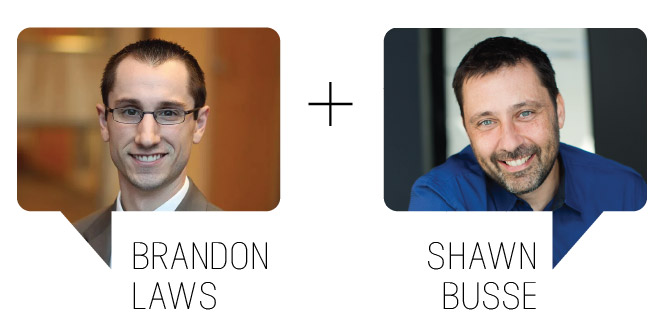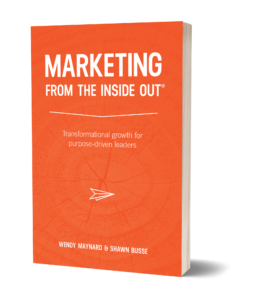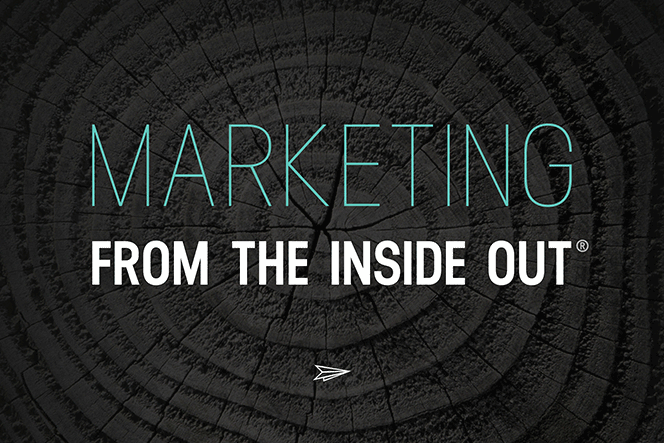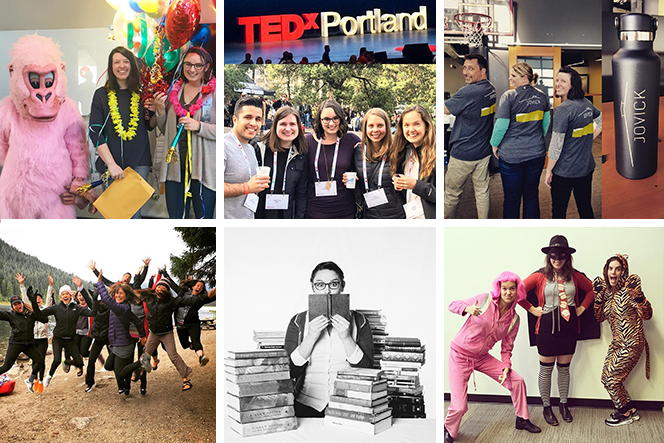
Meet Fluffy, Your 800-Pound Gorilla
Having a large customer the size of an 800-pound gorilla drives rapid revenue growth, but it also carries hidden dangers for your business.
Learn how to tame it.

If you're familiar with Kinesis, you know we're passionate about purpose - and our vision to support purpose-driven organizations with leaders who (to quote our own CEO Shawn Busse) "give a sh*t." As a part of this goal, Shawn has written a book - Marketing From the Inside Out: Transformational Growth for Purpose-Driven Leaders - which acts as a playbook to enact real and powerful change in these organizations.
Shawn recently joined the Human Resources for Small Business podcast to discuss the book - along with strategies for small businesses to find their purpose, foster great company culture, and build an actionable implementation plan.
A tool for HR professionals and small business leaders, the Human Resources for Small Business podcast is hosted by Xenium Director of Marketing Brandon Laws - and covers topics from business strategy, to leadership, to HR policy and more.
Check out the podcast and review the transcript below.

Brandon Laws: My friend Shawn, glad to have you on the podcast. So we’re talking about your book today. You wrote a book Marketing from the Inside Out: Transformational Growth for Purpose-Driven Leaders. Why did you write this book? Who is it for?
 Shawn Busse: This book is a great book for entrepreneurs or small business leaders who are looking to get their hands around how to do an authentic form of marketing, something that feels right to them and capitalizes on what makes them unique and remarkable.
Shawn Busse: This book is a great book for entrepreneurs or small business leaders who are looking to get their hands around how to do an authentic form of marketing, something that feels right to them and capitalizes on what makes them unique and remarkable.
Brandon Laws: What I felt was interesting about this book is that not only is it capturing the marketing side – and obviously that’s in the title – but the purpose-driven point really comes through in your subtitle, Transformational Growth for Purpose-Driven Leaders. So much of this book, especially in the initial chapters, is all about setting that purpose for the organization. We’re going to talk through some of that stuff. But why was that such an important piece for you?
Shawn Busse: You know, I’ve been at this for about 20 years. When I started my career, we had two types of clients. We had non-profit clients and we had for-profit businesses – and what we were trying to do was to get the non-profits to be more savvy about marketing and business acumen. That’s a tough challenge. And then more unexpected at the time, we were trying to get businesses to really have the heart of a non-profit, right? Because what we saw with the non-profit space was employees would work their hearts out for these organizations for very little money, long hours. You know, long careers.
So I was like, “Gosh. Why is it they will give so much over here for so little compensation and yet when you move into the business space, you have to use things like motivational gimmicks and bonuses and incentives?”
But then we would find these rare companies that really had a clear sense of purpose and mission (much like many really good non-profits would have), and they radically outperformed those that didn’t have a purpose, that didn’t have a sense of meaning and something greater than themselves.
Brandon Laws: So that’s what this book is really recommending to small business leaders, is that if you want to be really effective in the marketplace, have lots of high margin clients, and have a great business where you can hire lots of employees and provide opportunities, you have to do marketing from the inside out. What does that mean exactly?
Shawn Busse: In the book, we walk folks through the sequence. Essentially, at every business’s center should be a sense of purpose – mission, vision, and a set of values. And if you’re authentic about that, you can attract the next layer, which is a culture of top performing employees. And if you they’re going to deliver a remarkable experience. If you have a remarkable experience, your customers actually in many ways become your primary marketing engine for business.

Brandon Laws: I want to start by talking about a bad example, one where maybe the inside wasn’t so good and then it reflected poorly on the customers: Wells Fargo. Employees were incentivized with high commission or high pressure sales. They were starting to open up accounts for customers who didn’t authorize it. Things got so bad culturally, that then the reputation in the marketplace became really tainted. Talk about that.
Shawn Busse: I think the Wells Fargo case is such a great example of an organization meaning well in terms of trying to create shareholder value, so they created a set of incentives that they thought would encourage a certain behavior. But the thing about human beings is you have to be really careful with your incentives, because the consequences of incentives are often very powerful and unintended. It’s a great example of how when you think about your workforce like a machine, if I turn this lever, it will produce this result, you often get crazy outcomes that are counterproductive to what you’re trying to do.
Brandon Laws: Yeah, and what’s sad is that they’re so big it’s possible the CEO didn’t even really know about all this stuff happening. They’re so huge. There are thousands and thousands of employees… and I think what your book illustrates really well is that for small businesses, they have the opportunity to start from scratch. They can set that mission, vision, values and really integrate that into all their people practices. So that way, you know, the Wells Fargo example never would happen downstream.
Shawn Busse: In the Wells Fargos of the world, the large corporate organizations, it’s really difficult to move the needle. There’s so much entrenched behavior and culture. But in the small business space, you can set the course early and be effective.
Brandon Laws: So let’s start at the very beginning. Mission is what you really talk about. I feel like people get mission wrong a lot or they don’t even know what it is. Most employees probably can’t recite their mission in the organization they work for. Where do people start?
Shawn Busse: It’s really hard. The expression I use, which I borrowed from a friend of mine, is that it’s hard to read the label from inside the bottle. As a business, over time, you develop these behaviors and habits that are informed by what you stand for. But it’s hard for you to look at yourself and go, “Ah, this is what we stand for.” Kinesis’s mission is transformation. I really couldn’t put my finger on that until probably our 10th year in business. I think it’s that hard to self-diagnose.
I would argue that every business has a mission. It’s about uncovering that mission and that that mission should transcend business offerings. We’ve changed our business model probably three times in the 18 years we’ve been in existence. But it has always actually been the same mission. It has always been transformation, we just didn’t really articulate it at that point.
Brandon Laws: So why one word on the mission?
Shawn Busse: A good litmus test for whether or not your organization is following a shared mission is just go to your employees, especially the ones who are maybe lowest in the organizational hierarchy and ask them. "Hey, what’s our mission?" If you get different answers across all of those employees, then you as a leader probably haven’t done a great job of articulating what you stand for.
People have a hard time remembering full sentences, let alone paragraphs. But they can remember one word. What a one-word mission forces you to do is to get really, really clear on setting all that other garbage aside. What do we stand for? What is the one thing that we are all about?
Brandon Laws: I love that. How long should an executive team spend on creating that mission? Because I was shocked by the answer because I would think you need a week off site or whatever. What’s your answer on that?
Shawn Busse: I can say that we are able to help clients get there usually in an afternoon. But there’s a lot of back work that we’ve done. We dive a lot deeper into employee and customer interviews – you start to see trends and common ideas. That helps you get outside of what you think as an owner or as a leader, “Oh, we want to stand for service or excellence,” or these real cliché terms.
Brandon Laws: You said in the book, “Mission drives loyalty across the organizations.” How so?
Shawn Busse: Apple under the Steve Jobs era was tremendously successful. They stood for this idea of disrupting the status quo. They stood for building things that had never been seen before. That’s a really powerful thing to be a part of and it’s really hard to look at other companies who say, “Well, come to us and we will make widgets.” Who cares? So I think when you stand for something and that thing that you stand for is big and emotional and purposeful, you’re going to get people who want to sign up for that as opposed to people who are just looking for a job.
Brandon Laws: Yeah. You know what? I get so confused about it sometimes and I’m a marketing guy and I’m so ingrained in the culture work that we do at Xenium. But the difference between mission and vision has always been unclear to me sometimes because I think people use it interchangeably.
To me, it feels like mission should be this is what we’re in business to do. But vision is really that prediction about what it looks like if we actually see our mission through. Is that right?
Shawn Busse: I think that’s a good way to look at it. What I counsel people on is that a vision can actually change. When we crafted our vision in 2010, it was to reinvent how marketing was done for small businesses. That was a cool vision, and we realized it very effectively over the subsequent five years. We grew superfast as a result of having a clear vision.
More recently, we’ve reset that vision in a dramatic way. Not only do we want to reset the marketing landscape, we want to reset the business landscape and we want to do it for business owners who think with purpose. They may not be acting with purpose. They may not know how to do that. But they give a shit.
They care about their community. They care about their employees. It’s not just all businesses – our vision is to only work with businesses that are making a difference and making the world a better place. That gets harder, right? So that’s the other piece of a vision is it’s often something that’s like, “Wow. How are we going to do that? That’s difficult,” whereas a mission, we’re still living our life of transformation. We’re still adhering to what we stand for as an organization and that’s not going to change.
Brandon Laws: What’s a good way to deploy that vision across the company? Because I imagine sitting in a room with a bunch of executives. You create the vision. We’re going to be a $10 million company in 2020… But that doesn’t mean a lot to employees. They probably want to know how you’re going to get there. What are we going to look like? What kind of software are we going to have in place? What do you recommend there?
Shawn Busse: The first thing I recommend is don’t ever start with a financial number. I really don’t think the vast majority of employees are motivated by organizational financials. It’s a distraction.
I will just use us as an example. The bigger vision is to change the world through purpose-driven businesses. That’s what we want to achieve. I don’t know how we’re going to do it. I don’t know how we’re going to get there. But that’s the state.
Now, can I do that if I’m a 12-person company? It might be a little hard. So then supporting that vision may be, hey, we need to be at least a 50-person company. This much revenue is going to support the health of that size of company.
So then everything becomes a trickle-down and not a, “Well, here’s our financial performance,” and then all this other stuff is like window dressing. Unfortunately, that’s the problem with publicly-traded companies is they have to start with the financial performance.
So I would say start with something that’s exciting and attractive to you as an owner because you’ve got to be excited about it. But then it’s also going to be exciting and attractive to the internal customer who are called employees.

Brandon Laws: You had story in the book that I thought was beautiful. I think I’ve heard it before but I wanted to resay it on this podcast for those that may have never heard it. But this is where I think mission and vision work so well. At NASA, a journalist interviewed a janitor and ended up asking, “What’s your job here at NASA?” and he says, “My role is to put a man on the moon.”
Shawn Busse: You know, even to modern times, NASA has historically been listed as one of the best places to work. Why is that? Is it because they pay great wages? They probably don’t. You probably could make more money going to work for SpaceX or something like that. But at the end of the day, boy, you can’t really top a mission that involves putting humans up into space, exploring new worlds, finding water on Mars. I mean these are like powerful, big things that transcend small thinking, which is the pitfall of a lot of visions.
Brandon Laws: I want to switch gears a little bit and talk about customer service. Because I think the way your employees treat customers in the end probably has a lot to do with how you’re setting the purpose and mission and vision and all that.
So you gave a bad example of United Airlines. They’ve had a lot of bad press over the years. Why is that? If you were to guess, is this stemming from customer service training or is it just deeper than that?
Shawn Busse: I think it’s deeper than that. You could say things like shareholder primacy and this idea of the force of the market and they’re a publicly-traded company. But even within that realm, there are publicly-traded companies like Costco whose employees are very engaged and they treat their customers really well. So it’s not necessarily the fact that you are a publicly-traded company that dooms you to terrible customer service.
But there’s this old expression, “The fish rots from the head down.” So the culture and the tone and the tenor that the executive team puts out there matter. It makes a difference. You see organizations where the leadership say, “Employees matter and our values matter and living to those values is something we’re going to do, even if it causes us pain.” That sets a different standard and that creates a different customer experience.
Brandon Laws: Before we started recording, you were talking about a smaller company in Portland that does this really well, does it the opposite way of what United Airlines probably does.
Shawn Busse: Yeah. The company we’re talking about is my friend Bill’s company 3 Mountains Plumbing and they do service plumbing in the residential space.
Brandon Laws: Not sexy at all – dirty work. Literally cleaning shit up.
Shawn Busse: And yet their employees are friendly. They’re engaging. They’re strong communicators. They really are a sales force in many ways. They’re not just gruff plumbers who do a job. And what’s powerful about that story is that Bill has taken an industry that’s historically filled with gruff people and he has turned them into customer service geniuses.
As a result – I mean I was just looking at his website the other day. He has got trucks all over the place. I knew him when he had just one truck. That’s the power of service.
Brandon Laws: You talk about some of Seth Godin’s work. You talk about the book the Purple Cow about being remarkable. You had a heading in there and I wrote it down because I thought it was such a powerful statement. You said, “Nobody raves about average.” I love that because if you’re not setting a strong vision and you have a powerful mission and you don’t have the great people to back it up, you’re going to be average or below average and nobody gives a shit about average. Why do you think this is such a powerful thing?
Shawn Busse: The problem with average is that it quickly leads down the path to price. Let’s just take the retail space for example, right? You can go into Macy’s and you can have a very average experience. Sorry, Macy’s.
Brandon Laws: No, it’s OK. I think everybody shops on Amazon now for most of that stuff.
Shawn Busse: Right. And why do they shop on Amazon? Because they’ve never really had a remarkable experience at Macy’s. And you can contrast that with a lot of these new brands that are popping up where they don’t have all the inventory. They just have a very small store and you go in and you try on clothes. But it’s a very curated, high touch experience. They’ve sort of taken the Nordstrom experience and gotten rid of all the perils of inventory and all that sort of thing. But then they’ve amplified the service experience.
So I think there are real opportunities to be exceptional and to really yield a benefit from that. If you go down the average path, now you’re competing with Amazon and you cannot win against Amazon.
Brandon Laws: You spend a lot of the book – and especially on the second half – really talking about like really technical marketing stuff. It’s really a great marketing playbook for any small business leader. So if an executive small business owner is listening right now, this book has everything you need to have an effective marketing program. So I commend you on that.
You were talking about the website and how people are making snap second judgments on what they feel about your company or whether they want to read it or not. You said five milliseconds. How does that impact the candidate experience? So if you’re looking for talent, what does that say about your employer brand? What do you need to do as an employer?
Shawn Busse: If you think about the marketing space and what websites are trying to do, they’re trying to get new customers. And now with tools like Google, the customer is empowered. The customer has plenty of choices and the biggest nemesis to us is the back button. So you go to Google. You search for something. You think you found it. No, not it. Back. Next thing. Next, next, next.
I would argue that the employer space is suffering from that same challenge and business owners really haven’t acknowledged it. They are frustrated because they aren’t getting in enough applicants. They’re frustrated because the applicants aren’t very great. The problem is that what we’re putting in front of them makes the applicant hit the back button. Because we’re not putting energy into it. We’re not investing and selling the story of our brand. We’re not selling the story of our mission and our purpose.
Brandon Laws: We were joking a little bit ago about employers, how in this tight market right now with labor they can’t find talent. They’re just giving up. They’re throwing up their hands and saying, “Nothing works. I can’t find people.” You call BS on that. I know you do. What’s the solution there?
Shawn Busse: Put energy into it. I mean I think we’re in a situation that employers haven’t faced before, which is where the labor market has all the power and nobody has really dealt with this. So they don’t know what process to use. I would argue the process needs to be marketing holds hands with HR, because you need to use marketing as a tool to sell what you have to offer to those candidates and you need to put money into it. You need to create a career center. You need to invest time in caring for your Glassdoor profile. You need to get testimonials from employees and put those on the website. You need to craft meaningful job descriptions. All that stuff takes time and energy.
Brandon Laws: I am so glad you said Glassdoor because I wanted a marketer’s perspective on this. I’m a marketer myself. You have tons of experience in this area. Glassdoor, you get a bad review, a positive review. Do you respond? Do you not? If you do, what kind of responses are you doing?
Shawn Busse: Yeah. I think step one is acknowledge that it exists. I think a lot of businesses don’t know what Glassdoor is and yet they’re being reviewed on it. The other day, I looked up this business in a nearby city. I did a search for the business name and the second hit that came up on Google’s organic search results was the Glassdoor rating, which was terrible. So imagine you’re trying to sell the customers and they happen to stumble across that and they read what employees are saying about you.
So step one, acknowledge it exists. Step two, manage it. You can ask employees to participate in that process. Say, “Hey, this is optional. You don’t have to do it. I don’t want you to write a script. But you seem to be engaged here.” Give a voice to those employees who are passionate about what you’re doing and the benefit to them – and I would spell it out – is it helps us recruit more great employees who are like you. Then you get to work with great people. Then share that in the public space.

Brandon Laws: I want to wrap up talking about strategic planning. So you spend a good chapter talking about strategic planning, that it’s an important part of business no doubt. I don’t know if people are doing it really effectively. It’s just a brainstorming session whereas it should really be, what actions are we going to take. What comes out of that meeting that you’re sharing with employees, that are going to make them feel like they’re part of that meeting and are part of that future?
Shawn Busse: I think it’s really common to pivot to tactical problems. But the first thing to make a strategic planning successful is to have a clear vision for the company. So let’s assume you have a clear vision where you want to go and it’s hard and it’s a challenge. Now, you want to create something that’s actionable. I’m a big fan of simplifying strategic plans to a single page, that you can then share with the team, put it up on the wall. Everybody knows where you’re going, what you’re doing, so then they can support it.
Brandon Laws: I love it. OK, Shawn. Your book is Marketing from the Inside Out. You wrote it with Wendy Maynard. Is it for sale on Amazon? Where can people find it?
Shawn Busse: You can pick it up on Amazon and reviews are always appreciated. It helps others find the book and spread the word. That’s the easiest place to go.
Brandon Laws: Yeah. So let’s say for the HR people listening, this is probably a great book for their CEO/owner. Buy it. Put it in their hands and say, “Look, if we’re not clear about our mission and vision, this is the book for you.” You’re going to become a better marketer as a result of it too. So you’re not only going to find the great people that you need to do a great job in the market. You’re going to probably attract more customers as a result of it.
Shawn Busse: Yeah, great book for CEOs, owners of small businesses. I know you have a big HR audience for that. For that group, there’s a ton of good stuff in there around employer branding, recruiting a better type of candidate and I think you can really use this as a tool to align leadership with what you’re trying to achieve in HR.
Brandon Laws: Yeah. Well, it was a lot of fun, Shawn. Thanks for being part of the podcast.
Shawn Busse: Thank you.
Interested in learning more about how to transform your company's marketing and culture for profound business growth? Check out Shawn’s book or contact us via the form below.
Get insights like this straight to your inbox.